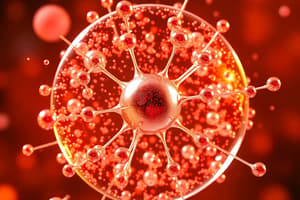Podcast
Questions and Answers
According to particle theory, what happens to the movement of particles in a solid when it is heated?
According to particle theory, what happens to the movement of particles in a solid when it is heated?
- They move in straight lines.
- They speed up and vibrate more. (correct)
- They stop vibrating completely.
- They slow down and move closer together.
Which statement describes the arrangement and movement of particles in a liquid?
Which statement describes the arrangement and movement of particles in a liquid?
- Particles are widely dispersed with no attraction between them.
- Particles are free to move randomly with weak attractions. (correct)
- Particles vibrate in a regular lattice structure.
- Particles are held in fixed positions with strong attractions.
What happens to the density of a substance as it changes from a liquid to a gas?
What happens to the density of a substance as it changes from a liquid to a gas?
- Density slightly increases.
- Density decreases significantly. (correct)
- Density increases significantly.
- Density remains the same.
What is the primary difference in particle behavior between a gas in a container with fixed walls and a solid?
What is the primary difference in particle behavior between a gas in a container with fixed walls and a solid?
According to kinetic theory, what causes gas pressure inside a closed container?
According to kinetic theory, what causes gas pressure inside a closed container?
Which change of state involves the absorption of heat, leading to increased particle movement and a change from a more ordered to a less ordered state?
Which change of state involves the absorption of heat, leading to increased particle movement and a change from a more ordered to a less ordered state?
If a sealed container of gas is cooled, what happens to the speed of the gas particles and the pressure inside the container?
If a sealed container of gas is cooled, what happens to the speed of the gas particles and the pressure inside the container?
What is a key difference in the arrangement of particles between a solid and a gas at the same temperature?
What is a key difference in the arrangement of particles between a solid and a gas at the same temperature?
A substance changes from a liquid to a solid state. What happens to the potential energy of the particles during this process?
A substance changes from a liquid to a solid state. What happens to the potential energy of the particles during this process?
Why does a gas not have a definite shape or volume?
Why does a gas not have a definite shape or volume?
A closed container contains a fixed amount of water. If all the water evaporates, which property remains the same?
A closed container contains a fixed amount of water. If all the water evaporates, which property remains the same?
Which of the following best explains why solids have a definite shape and volume?
Which of the following best explains why solids have a definite shape and volume?
When a liquid boils, what is the primary change occurring at the particle level?
When a liquid boils, what is the primary change occurring at the particle level?
How does the particle theory describe the characteristics of an ideal solid?
How does the particle theory describe the characteristics of an ideal solid?
Liquids can flow and take the shape of their container. Which property of liquid particles allows this to happen?
Liquids can flow and take the shape of their container. Which property of liquid particles allows this to happen?
If you compress a gas into a smaller volume, what happens to its density?
If you compress a gas into a smaller volume, what happens to its density?
What is the critical difference in particle movement that distinguishes evaporation from boiling?
What is the critical difference in particle movement that distinguishes evaporation from boiling?
According to the kinetic theory, if the temperature of a gas increases in a container with a constant volume, what also increases?
According to the kinetic theory, if the temperature of a gas increases in a container with a constant volume, what also increases?
Imagine you have a balloon filled with air. What happens to the balloon's volume if you cool it down, assuming the pressure remains constant?
Imagine you have a balloon filled with air. What happens to the balloon's volume if you cool it down, assuming the pressure remains constant?
Flashcards
What are the three states of matter?
What are the three states of matter?
Matter exists primarily in these three forms.
What is the Particle Theory?
What is the Particle Theory?
A model where particles are small, solid, and inelastic spheres.
What are Solids?
What are Solids?
Particles are held tightly in a fixed, regular lattice structure. Definite shape and volume.
What is the melting point?
What is the melting point?
Signup and view all the flashcards
What are Liquids?
What are Liquids?
Signup and view all the flashcards
What is the boiling point?
What is the boiling point?
Signup and view all the flashcards
What are Gases?
What are Gases?
Signup and view all the flashcards
What is condensation?
What is condensation?
Signup and view all the flashcards
What is freezing?
What is freezing?
Signup and view all the flashcards
What happens to mass during changes of state?
What happens to mass during changes of state?
Signup and view all the flashcards
What is density?
What is density?
Signup and view all the flashcards
Which state of matter is most dense?
Which state of matter is most dense?
Signup and view all the flashcards
Which state of matter is least dense?
Which state of matter is least dense?
Signup and view all the flashcards
Study Notes
- The video discusses the three states of matter: solid, liquid, and gas.
- Substances can change from one state to another.
- The explanation relies on the particle theory.
- The particle theory, sometimes called kinetic theory, models particles as small, solid, inelastic spheres.
Solids
- There are strong forces of attraction between the particles.
- Particles are held close together in a fixed position.
- They form a regular lattice structure.
- The substance maintains a definite shape and volume.
- Solids cannot flow like a liquid, holding its form.
- Particles vibrate around, jostling against one another without changing position.
- Heating a solid causes particles to gain energy and vibrate more.
- Increased vibration weakens the forces between particles.
- At the melting point, particles gain enough energy to break free of their bonds.
- This causes the solid to melt into a liquid.
Liquids
- There are weak forces of attraction between the particles.
- Particles are free to move around randomly.
- Weak forces allow particles to stick together and remain fairly compact
- Liquids have a definite volume but can change shape.
- They can flow to fit a container.
- Heating a liquid increases particle energy and speed.
- Increased speed weakens the forces holding particles together.
- At the boiling point, particles gain enough energy to break bonds altogether.
- The liquid boils or evaporates into a gas.
Gases
- The force of attraction between particles is very weak.
- Particles are essentially free to move around independently.
- Gases do not keep a definite shape or volume.
- They fill a container by spreading out as much as possible.
- Gas particles move in straight lines, not randomly swerving.
- Particles can travel in any direction being randomly deflected by solid walls and other gas particles.
- Pressure increases when a gas is heated in a fixed container.
- Cooling a gas reduces particle energy, decreasing speed.
- Reduced energy allows forces of attraction to form bonds between particles.
- This condenses the gas into a liquid.
Changes of State
- Cooling a liquid reduces particle energy, decreasing speed.
- Reduced energy allows attractions to form more bonds and Fixing particles in place
- This freezes the liquid into a solid.
- Changes in state within a closed system do not change the mass.
- The number of particles remains the same.
- Density changes with the state of matter.
- Solids have the highest density.
- Liquids have slightly lower density.
- Gases have the lowest density.
Studying That Suits You
Use AI to generate personalized quizzes and flashcards to suit your learning preferences.



